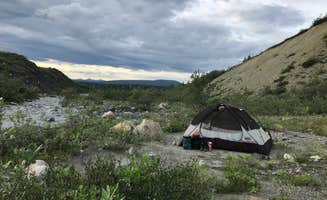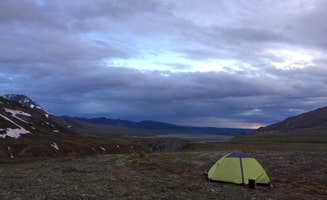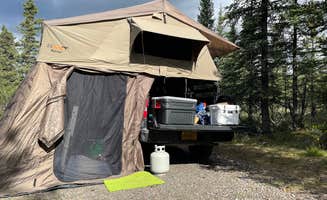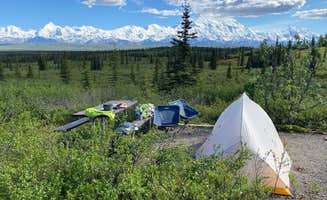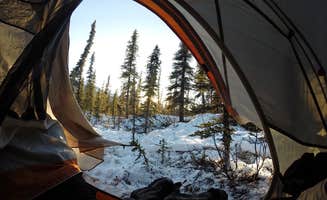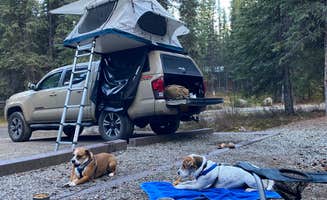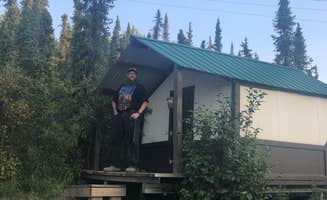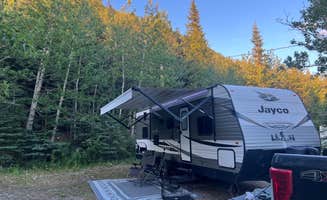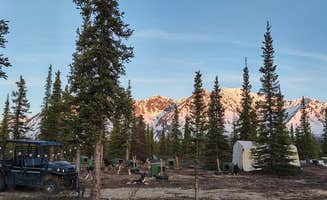Camping in Denali National Park and Preserve offers experiences across 6 million acres of wilderness with elevations ranging from 1,000 to over 20,000 feet at Denali's summit. Temperatures during camping season typically range from 30-70°F with weather conditions changing rapidly. The main camping season runs from late May to early September, with seasonal variations affecting water levels in streams and wildlife movement throughout the park.
What to do
River exploration: Take a walk along Teklanika River bar from Teklanika River Campground. The gravel bar makes for excellent hiking adventures. "We really enjoyed that we could drive our car further into the park to camp in this campground. Short walk to the gravel bar and Teklanika River. Nightly ranger programs," notes Stacey C.
Wildlife watching: Climb hillsides for better viewing. Away from campgrounds, higher elevations offer better wildlife spotting. "After setting up camp I scrambled up the hill on the other side of the road and watched the caribou herd for what seemed like forever," shares Ashley Y. from Teklanika River Campground. Bears, moose, and caribou are commonly spotted throughout the park.
Photography: Capture early morning light. The changing conditions create dynamic photo opportunities. "We took advantage of the ranger talk that was given in the evening," adds Katie B. who stayed at Savage River Campground. Many campers recommend morning hours for best light and wildlife activity.
What campers like
Privacy in remote sites: Riley Creek Campground offers separated sites despite being near the entrance. "The surrounding trees provide a nice barrier between sites so you don't feel crammed into the campground," writes Staci J. The raised bed areas for tents and gravel pads for RVs help define personal space.
Bus system flexibility: The park's transportation system can enhance camping experiences. "We bought a bus pass so we could take daily trips to a part of the park we wanted to explore and then would hop back on when we were done," explains Stacey C. from Teklanika River Campground. This allows campers to access distant trailheads without moving camp.
Midnight sun viewing: Summer campers experience extended daylight. "We camped in a tent under constant daylight and got down to 40s between 3-5am," reports Angie G. about camping at Savage River. Temperatures typically drop significantly at night despite nearly continuous daylight during peak summer.
What you should know
River crossings require skill: Backcountry camping demands preparedness, especially for water crossings. "If you do not trust your river crossing skills to the highest level, do NOT cross the rivers. My friend and I got stuck on the other side of the river with those aforementioned grizzly bears and had to camp an extra night," warns Gillian H. about Backcountry Unit 31: Polychrome Mountain.
Bear safety is essential: All food must be properly stored in provided lockers or bear-resistant containers. "We saw bears along the road but no evidence of them near the campsite thanks to the rules in place (store food in lockers)," explains Amber A. who camped at Wonder Lake.
Mosquitoes are persistent: Bring appropriate protection, especially in lower elevations. "Unit 34 is plagued by marsh and thousands of mosquitos, but if you have mosquito gear and get up the mountain as quickly as possible you should be fine," advises Gillian H. Many campers recommend head nets in addition to repellent.
Tips for camping with families
Pack extra layers: Temperature fluctuations require preparedness. "You can hear the river flowing and it can lull you to sleep despite the near constant daylight," shares Angie G. from Wonder Lake Campground. Nights can drop to near freezing even in summer months.
Join ranger programs: Educational opportunities enhance family experiences. "We attended a great ranger talk and had some fabulous mountain views," writes Abby M. about Savage River Campground. Programs typically run in the evenings at most established campgrounds.
Use discovery backpacks: Available for children at visitor centers. "If you have kids, be sure to check out a discovery backpack filled with activities and science kits they can use. Our 9-year-old loved it so much she asked for a science kit for Christmas!" recommends Abby M.
Tips from RVers
RV restrictions vary by campground: Know which sites can accommodate your vehicle size. "This campground has a great drive that goes along with it no matter where you are coming from," notes Tanya B. about Riley Creek Campground. Riley Creek can accommodate larger RVs while campgrounds further in the park have more limitations.
Plan for no hookups: All campgrounds in Denali National Park lack full hookups. "There is a free dump station and water," explains Delaine N. about Riley Creek. Generators are not permitted in most campgrounds, requiring RVers to be self-sufficient.
Minimum stays apply at certain campgrounds: "My husband and I stayed here in a rented rv for the most memorable camping experience of my life," shares Marisa A. about Teklanika River Campground. "This site is close enough to the river for taking lunch hikes along the park service road." Teklanika requires a minimum 3-night stay for private vehicles.


